- elevation 4,600 ft (1,402 m) | - elevation 3,100 ft (945 m) | |
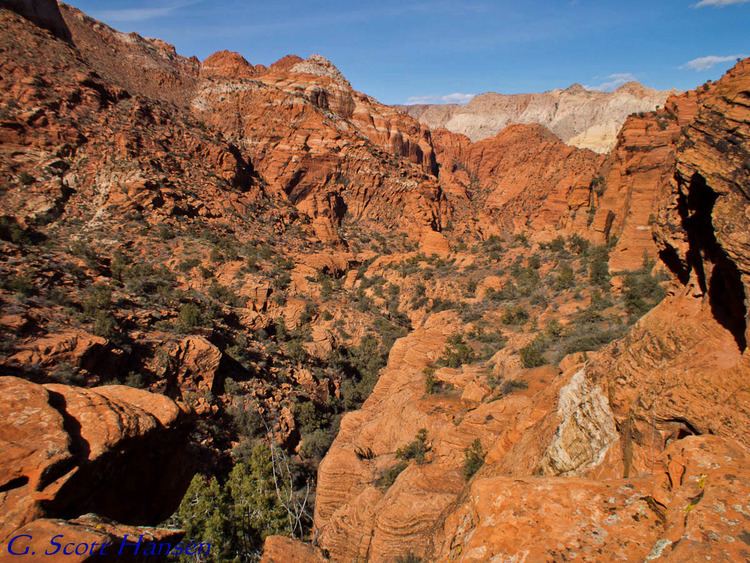 | ||
Rainstorm in padre canyon snow canyon state park august 7 2015
Padre Canyon is adjacent to Red Mountain in Ivins, Utah, USA, featuring a 3 sided canyon and scenic sentinels carved from the red Navajo Sandstone. Padre Canyon is at the merging of three great ecosystems, the Mojave Desert, the Colorado Plateau and the Great Basin. The area is biologically rich with a unique combination of plants and animals rarely seen in one place. Other geological features of the canyon include Padre Rock, the Padre Arch, pillared rock formations and sand dunes. During the rainy season, waterfalls are present on the rocky western aspect.
Contents
- Rainstorm in padre canyon snow canyon state park august 7 2015
- AboutEdit
- FacilitiesEdit
- ClimateEdit
- HistoryEdit
- Flora and faunaEdit
- GeologyEdit
- TrailsEdit
- References

AboutEdit
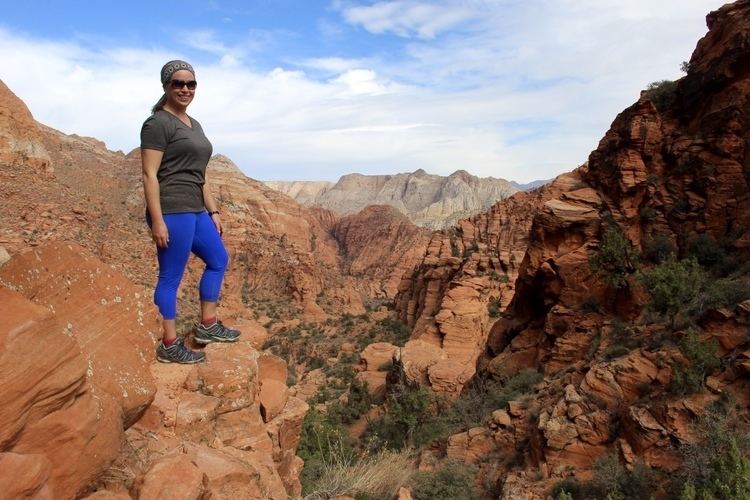
Padre Canyon is in southwest Utah, 50 miles West of Zion National Park with a valley elevation of 3100 feet above sea level. Padre Canyon is a three sided canyon oriented north to south.
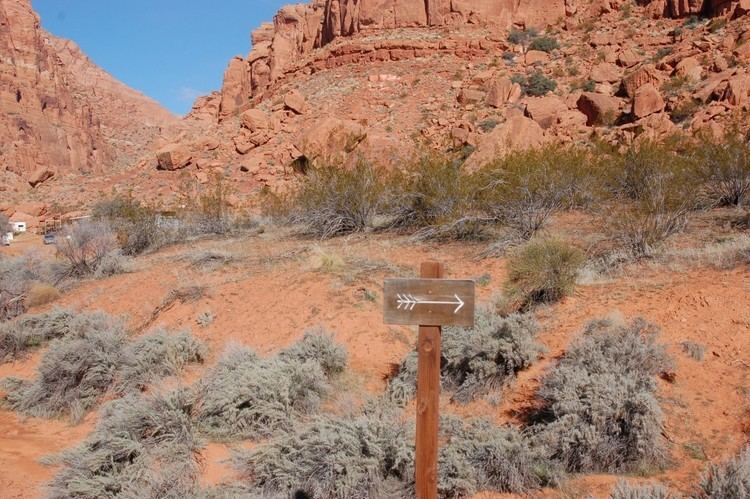
To the east is steep sloping hillside that gradually merges upward into vertical Kayenta and Navajo Sandstone cliffs at 4000 feet elevation. The east side of the canyon descends southward to 3500 feet and abruptly terminates in the North Black Rocks lava field.
The north end of the canyon is a saddle with a trail peak of 3740 feet in altitude.
The west side of the canyon is Red Mountain at 4500 feet in altitude.
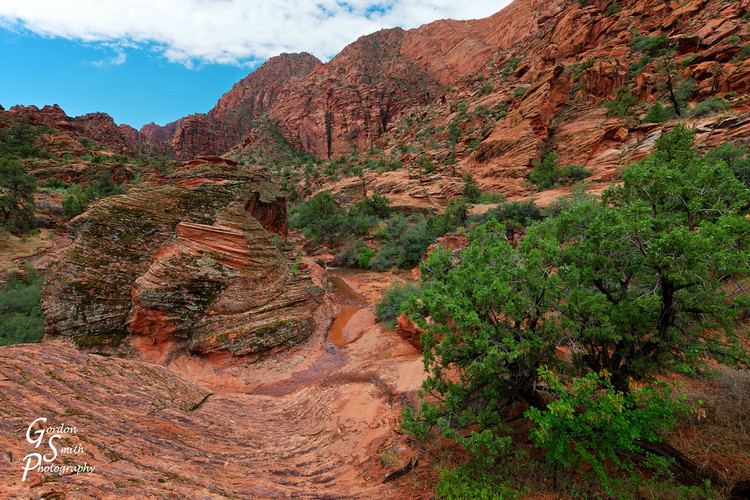
To the south of the canyon is the low lying basin of the Mohave Desert with vistas of the Utah Range, the first in a long series of ranges of the Basin and Range Physiographic province.

The area is bordered and protected by Snow Canyon State Park, the Red Cliffs National Conservation Area (managed by the Bureau of Land Management), and the Red Cliffs Desert Reserve.. The canyon is adjacent to the Red Mountain Wilderness.
FacilitiesEdit
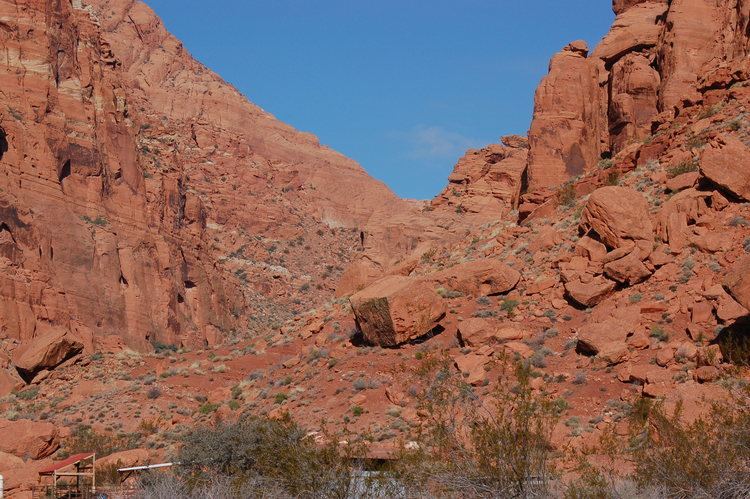
Padre Canyon is car accessible on Tuacahn Drive and hiking accessible at the Padre Canyon Trailhead. Parking is available at the end of Tuacahn Drive public access, the Padre Canyon Trailhead and at the spur of the Toe Trail. No bathrooms, picnic areas or campgrounds are available. There is virtually no trailer parking.
ClimateEdit
The area is desert climate and in summer can be hot during the day and warm at night with Fall and Winter months more temperate during the day and cool to cold at night. Summer nights are an average temperature in the low 70 °F (21 °C) to daytime high temperatures over 105 °F (41 °C). Winters can range from lows in the mid 20 °F (−7 °C) to highs in the 60 °F (16 °C) range. The area sees regular light precipitation of half an inch to an inch average each month with the exception of May and June when precipitation reduces to one-quarter inch average.
HistoryEdit
The area adjacent to Padre Canyon was designated as Snow Canyon State Park in 1958. Ancestral Puebloans inhabited the region from AD 200-1250, utilizing the canyon for hunting and gathering. Paiute Indians were present in the region from AD 1200 to the mid-19th century. Mormon pioneers discovered the area in the 1850s while searching for lost cattle.
Nearby areas have visible evidence of fossilized dinosaur tracks. Early human evidence is also visible in rock etchings and petroglyphs.
Flora and faunaEdit
The vegetation of the area mainly consists of desert plants.
Wildlife in Snow Canyon includes the Gila monster, peregrine falcon, and desert tortoise. Small fences to keep the ground-dwelling creatures from accidentally wandering onto roads can be seen across Snow Canyon and the St. George area. Other notable wildlife include the giant desert hairy scorpion, coyote, Mojave sidewinder, red-spotted toad, Utah banded gecko, and the side-blotched lizard, among many others.
Padre Canyon has views of Snow Canyon State Park backcountry. During the springtime this area shows desert wildflowers of desert baileya, banana and soap tree yucca, brittle brush, creosote bush, indigo bush, purple sage, range ratany, palmers penstemon, hedgehog and prickly pear. Wash areas host tamarisk.
Wildlife includes the Gila monster, peregrine falcon and desert tortoise. In 1990, the U.S. Fish and Wildlife Service listed the Mojave Desert tortoise as a "threatened" species. Small fences to keep the ground dwelling creatures from accidentally wandering onto roads border the roadway into the canyon. Other notable wildlife include the giant desert hairy scorpion, coyote, Mojave sidewinder, red-spotted toad, Utah banded gecko, and the side-blotched lizard, among many others.
GeologyEdit
Padre Canyon is within Washington County, which lies on the Hurricane Fault. The fault bisects the county, and is visible at the Hurricane Cliffs, which run south to the Grand Canyon. The fault has exposed colorful layers of rocks dating back to the age of the dinosaurs and older. Most of the scenic red rock is known as Navajo Sandstone. Navajo sandstone was created from layers of cemented sand that blew into Utah nearly 200 million years ago. In the past million years, eruptions of several cinder cones and lava flows scattered the ground with black basaltic rocks.
TrailsEdit
Padre Canyon Trail – 4.7 miles (7.6 km). Medium to hard, maneuvering through slots, off ledges, and through holes on your knees, and may involve some wading, especially in the winter and spring. Highlights include slickrock hiking, arched alcoves, the Doll House and an undisturbed ecosystem. It is not recommended for those without some backcountry experience.
Red Mountain Route - 10.8 miles (17.4 km). Strenuous. Primitive route is remote and faint in places, great panoramic views, extreme caution is recommended.
Toe Trail – 2.8 miles (4.5 km). Easy trail. Follows Ivins flood control dike.
